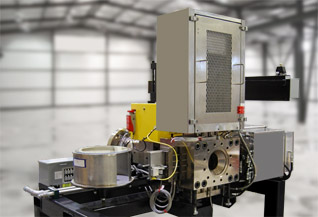

November 28 2018

Continuous-belt screen changers are an economical and efficient method of filtering out contaminants in thermoplastic material due to their ability to provide constant melt extrusion pressure to downstream processes over long periods of time. The absence of process interruptions needed to change screen packs in other types of filtration translates into increased production and decreased scrap, bringing maximum efficiency to your extrusion operation. However, if you notice that the pressure drop in your continuous belt screen changer is gradually increasing over time, despite regularly advancing the screen at recommended intervals, you may have a flow restriction from the gradual buildup of contaminants on breaker plate surfaces, also known as “plate out.” For many thermoplastic materials this will not be an issue. For some, however this will cause restriction in flow requiring removal and cleaning of the breaker plate.
Breaker plates are common in the extrusion industry and serve two main purposes: to help mix molten polymer as it exits the extruder (eliminating rotational memory and creating longitudinal memory); and to support the filtration media. Filtration media does not have the strength to support itself across the flow channel and the breaker plate on which the media rests provides the needed strength to withstand the high extrusion pressures seen during operation. A manufacturer must balance the design requirements of a breaker plate so that the cumulative area of the flow passages (typically circular holes) are large enough to minimize pressure drop across the breaker plate while also being small enough so that the screen won’t dimple into the holes.In a continuous style screen changer this dimpling will cause the screen to “pin” itself to the breaker plate creating issues when advancing the screen.
While the breaker plate is a necessity to provide support to the filtration media, it also presents its own complications. The holes in the breaker plate provide a large surface area on which material can gradually build up to the level where “plate out” can occur, thus reducing the cumulative area through which polymer can flow. This occurrence ultimately results in an unacceptable pressure drop across the breaker plate to the point where it needs to be replaced with a clean one.
Another area of concern is when making a material, grade, or color change. Many times, this requires replacing the breaker plate and/or filtration screen to minimize cross-contamination.
To address these issues, Key Filters developed the KCH-QC, an innovative continuous-belt screen changer with a “quick-change” breaker plate. The KCH-QC was engineered to drastically reduce the amount of time it takes to replace the breaker plate and introduce clean screen into the process. The screen changer’s unique design allows rapid change-out of the breaker plate in under five minutes, which normally could take up to four hours of downtime. Without the use of tools, the clean breaker plate is actuated into position while pushing the contaminated breaker plate out of the melt stream. Then the hydraulic puller, which is featured on all KCH models, allows the operator to pull clean screen into the melt stream in a matter of minutes. The used breaker plate can then be cleaned, allowing it to be reused at the next change-out cycle.
Plastic extrusion processors are always searching for ways to increase productivity and improve product quality and yield. The KCH-QC fulfills this need by providing a quick and easy solution that substantially reduces downtime and scrap when plate-out and cross-contamination risks are present.